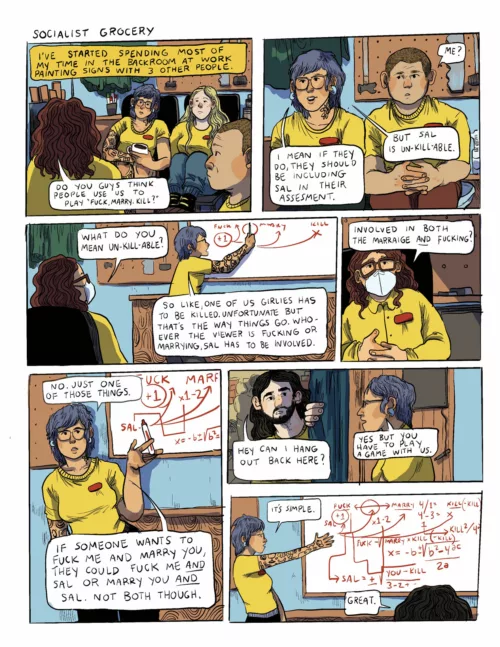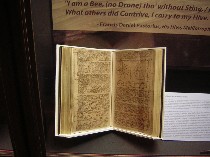 What does an installation about beehives and archives have to do with tsunami? I’ll let you know at the end, but that’s just one of the many reasons to see that installation by my favorite philosopher/curator/artist Aaron Levy, in the Annenberg Rare Book & Manuscript Library at the University of Pennsylvania (34th and Walnut, 6th floor) until March 7.
What does an installation about beehives and archives have to do with tsunami? I’ll let you know at the end, but that’s just one of the many reasons to see that installation by my favorite philosopher/curator/artist Aaron Levy, in the Annenberg Rare Book & Manuscript Library at the University of Pennsylvania (34th and Walnut, 6th floor) until March 7.
The installation, “The Revolt of the Bees, Wherein the Future of the Paper-Hive is Declared,” is part philosophical harangue–a series of 11 propositions or “lessons,” part art, part archive and 100 percent metaphor. Even though the piece is academic and loaded with more words than honey, I found it worth all the time it required me to spend, looking, reading, imagining, exploring its byways, and thinking. In short, it fits Levy’s definition of a hive.
Archive art has become more and more of a presence, and if you want to compare one archival installation to another, you might want to make a trip to the David Bunn/Madena Asbell installation over at Temple University’s gallery in Old City (see Roberta’s post). Bunn’s archive is more about the past, however. Levy’s archive is about the future and survival.
“Revolt of the Hive,” of the two, resonates in more directions–and not just temporal directions.
Here’s what it has to offer:
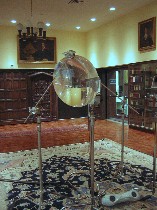
A swell video installation showing the archives of Stephen Girard, in its complete disarray in Founder’s Hall at Girard College. It’s a metaphor for archival failure–saving without applying the intelligence of a curator or arhivist. The film is beautiful, the lighting passing over the mess quite poetic (left, part of the video installation, in which tiny high-tech monitors can be viewed through old-fashioned giant lenses) .
The Stephen Girard angle is not the only piece of Philadelphiana included. Two commonplace books from Francis Daniel Pastorius (1651-1719), the namesake for Pastorius Park on Germantown Avenue teach the first lesson: “The hive is a living organism.” The hive, which is a metaphor for the archive, is what Pastorius’ books are–compilations of commonplace knowledge and miscellany that perpetually changes as information and observations are added to them, day-book fashion (top image in post, Pastorius’ “The Bee-Hive” commonplace book).
A (somewhat clunky) reliquary with beekeeping references in its shape and details holds crushed pages of a 17th century edition of the King James Bible (image, right, with Bible in box in front of vitrine showing shaman-artist Joseph Beuys pouring honey). Surprise. The Bible is in disarray, and therefore its preservation is pointless. (A sign next to the reliquary attests that the Bible did not come from Penn’s Rare Books library (I could hear audible sighs of relief) and that it was destroyed by water before Levy got his hands on it. Now you know for sure that Levy is a nice guy who would never destroy a historic King James Bible.
Library display vitrines contain professional beautiful blow-ups of prints–mostly from some of the books in the exhibit. The vitrines also display quotes from old books about bee keeping and bee hives and their relevance to society and archiving, the lesson each quote represents, and the old books themselves. (Also included is a philospher/fantasist architect’s plan for the “Living Body Musemeum,” never realized, by Arakawa + Gins).
The embodiment of this piece with its archival references in a real archive was perfect.
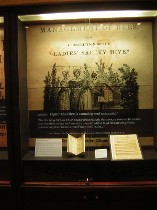 What I loved about this piece, knowing that Levy is a curator and an artist and a philosopher (who amongst you can walk by Slought Foundation and not stop in for a chat with him?) is that he is putting forth an argument that the artist and the curator and thinker are the keepers and selectors and therefore the implementers of societal wisdom. In other words, Levy posits that thanks to him and guys like him, we will survive as a culture (left, one of the vitrines). He’s the king of the bee hive archivists and it’s a triple crown he sports.
What I loved about this piece, knowing that Levy is a curator and an artist and a philosopher (who amongst you can walk by Slought Foundation and not stop in for a chat with him?) is that he is putting forth an argument that the artist and the curator and thinker are the keepers and selectors and therefore the implementers of societal wisdom. In other words, Levy posits that thanks to him and guys like him, we will survive as a culture (left, one of the vitrines). He’s the king of the bee hive archivists and it’s a triple crown he sports.
The culture’s survival is tantamount to our own survival–and of course, by leaving his personal mark on the archive, the culture’s survival is tantamount to Levy’s survival. Our obsessive fear of death is misplaced.
The magic here is what a personal expression this is from Levy. (My personal philosophy is that all decent artists make pieces about themselves and all decent curators create shows that reflect themselves, and this show is pure Levy).
I don’t think everyone will love this piece. It’s like almost everything at Slought, cocooned in layers of intellectualization and philosophical positioning. But I did love it. If you’re looking for a juicy painting, however, fuggedaboutit.
Here’s where tsunami comes in. Did you read about the tribe that survived tsunami last week because of superior archiving? The tribe’s oral history and learning stated that when the waters in the ocean recede dramatically, run like hell to higher ground. They did. They survived. A honey of an archive.
The more “modern” people did not save that critical bit of information in their archive, or if they did, it’s not well archived, lost amidst all the other info. Many died as a result.
In the time of the computer, the ultimate archive of retrievable as well as disordered information, this piece seems so appropriate. I took its thoughts home with me, and am thinking of lots of ways and places begging for hive-thinking (my desktop disarray? my family’s ideal little subsociety/hive). Buzzzz.


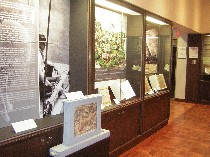 A (somewhat clunky) reliquary with beekeeping references in its shape and details holds crushed pages of a 17th century edition of the King James Bible
A (somewhat clunky) reliquary with beekeeping references in its shape and details holds crushed pages of a 17th century edition of the King James Bible 



